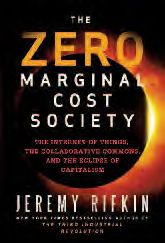SEJournal Online is the digital news magazine of the Society of Environmental Journalists. Learn more about SEJournal Online, including submission, subscription and advertising information.

BookShelf
"The Zero Marginal Cost Society: The Internet of Things, the Collaborative Commons, and the Eclipse of Capitalism"
By Jeremy Rifkin
Palgrave Macmillan, $28
Reviewed by CANDACE S. HUGHES
New York Times bestselling author Jeremy Rifkin – lecturer, consultant, and author of about 20 previous books – details how the web could alter our economy and save resources in “The Zero Marginal Cost Society: The Internet of Things, the Collaborative Commons, and the Eclipse of Capitalism.”
Throughout the book’s 356 pages, Rifkin shows how a new economic, web-based paradigm is leading to what he believes will be the gradual decline of capitalism as we know it today.
Capitalism, he writes, has had a good run with a substantial impact on human history. But he also makes a case for why he believes the success of capitalism may also be causing its own death.
Every aspect of our lives has been transformed into economic viability, as have our natural resources. He gives water as an example, saying how it can now be bottled and delivered to market for us to purchase.
The danger of this, according to Rifkin, is that the market has come to define us.
Rifkin notes that even Adam Smith, in his classic “The Wealth of Nations,” also predicted that the reaction to supply and demand could have its dangers.
But Rifkin writes that the new Internet technology shows greater productivity, and eventually more goods and services will be almost free and the marginal cost society will become a reality, bringing about an end to consumerism.
Then, as we work less and spend less time accumulating wealth in order to buy consumer products, we will have more time for nature, giving us more of a chance for transcendence and additional time to pursue personal improvement.
Candace S. Hughes is an Arizona-based freelance writer and an SEJ member.
* From the quarterly newsletter SEJournal, Fall 2014. Each new issue of SEJournal is available to members and subscribers only; find subscription information here or learn how to join SEJ. Past issues are archived for the public here.













 Advertisement
Advertisement 



